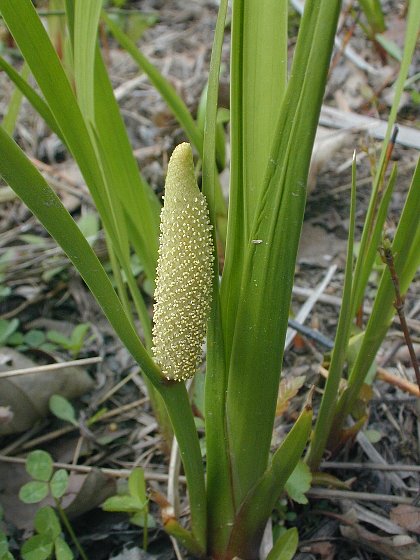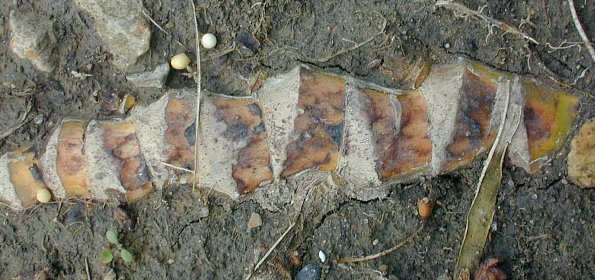Description: This perennial plant is 1–3½' tall, consisting of tufts of basal leaves that emerge directly from a spreading rootstock. These basal leaves are erect and sword-shaped, resembling the basal leaves of Iris spp. (Irises), but more green. They are flattened (on one side more than the other), smooth along the margins, and have parallel veins. There is often an off-center ridge/indentation along the length of each leaf. Sometimes the base of the leaves or their margins are slightly red. Some leaves develop a cylindrical spadix that is about 2–4" in length and semi-erect. This spadix is covered with tiny greenish yellow flowers in a diamond-shaped pattern. Each flower has 6 tepals and 6 stamens. The spathe is regarded as absent by some authorities, while others consider the spathe to be a bract-like extension of the basal leaf. The blooming period occurs from late spring to early summer and lasts about a month. Both the crushed foliage and rootstocks have a pleasant aromatic fragrance. Because Sweet Flag is a sterile polyploid species, it doesn't produce any fruit with fertile seeds. The root system consists of shallow branching rhizomes that are stout and knobby; they have a brown exterior and white interior. Tufts of basal leaves occur at intervals along these rhizomes, while coarse fibrous roots develop below. This plant spreads vegetatively by its rhizomes and often forms colonies.

Cultivation:
The
preference is full or partial sun and wet mucky ground or shallow water
along shores. This species is semi-aquatic. It is fairly easy to
establish from pieces of the rhizome.
Range & Habitat:
The non-native Sweet Flag occurs occasionally throughout Illinois,
although it is less
common or absent in the NW and southern areas of the state (see Distribution
Map). It was introduced into North America for medicinal,
ornamental, and other purposes. Sweet Flag is native to India, central
Asia, and probably Eastern Europe. Habitats include sedge meadows that
are prone to
flooding, edges of small lakes and ponds, marshes, swamps, seeps and
springs, and wetland restorations. Even though this is an introduced
plant, it has been found in both high quality and degraded wetlands.
Faunal Associations:
Sweet Flag (Acorus calamus) is the preferred host plant of a leaf beetle, Plateumaris shoemaker. Other leaf beetles that feed on this plant include Donacia caerulea and Donacia subtilis
– these beetles feed primarily on the roots and leaves (Clark et al.,
2004; Harms & Grodowitz, 2009). Among vertebrate animals, Muskrats
have been observed to feed on this plant (Hamerstrom & Blake, 1939).
Photographic Location:
Along the shore of a small lake at a city park in Champaign, Illinois.

Comments: The rootstocks of this aromatic plant are used as a natural insecticide and an ingredient of perfumes. They were used by Amerindians for various medicinal purposes, and reportedly induce hallucinations if eaten in sufficiently large quantities. These properties are primarily the result of Alpha-asarone and Beta-asarone; the latter has been found to be carcinogenic. As a consequence, the Food & Drug Administration (FDA) has banned the use of the rootstocks as a food additive. A similar species, Acorus americanus (American Sweet Flag), is restricted to the northern half of North America. It is virtually identical to Acorus calamus (Sweet Flag), except that it has several prominent veins along the length of each leaf. Sweet Flag has a single prominent vein on each leaf that is marked by an off-center ridge/indentation along its length. Another difference is that American Sweet Flag is a fertile diploid that produces fruit with viable seeds. In the past, this species was regarded as a variety of Sweet Flag, and it was referred to as Acorus calamus americanus. American Sweet Flag contains Alpha-asarone, but it lacks significant amounts of the carcinogenic Beta-asarone – therefore, it may be safer to use in the preparations that are described above. The Acorus spp. (Sweet Flags) were classified in the Araceae (Arum family) in the past, but they have been reclassified to their own family, the Acoraceae, as a result of recent chromosomal studies.